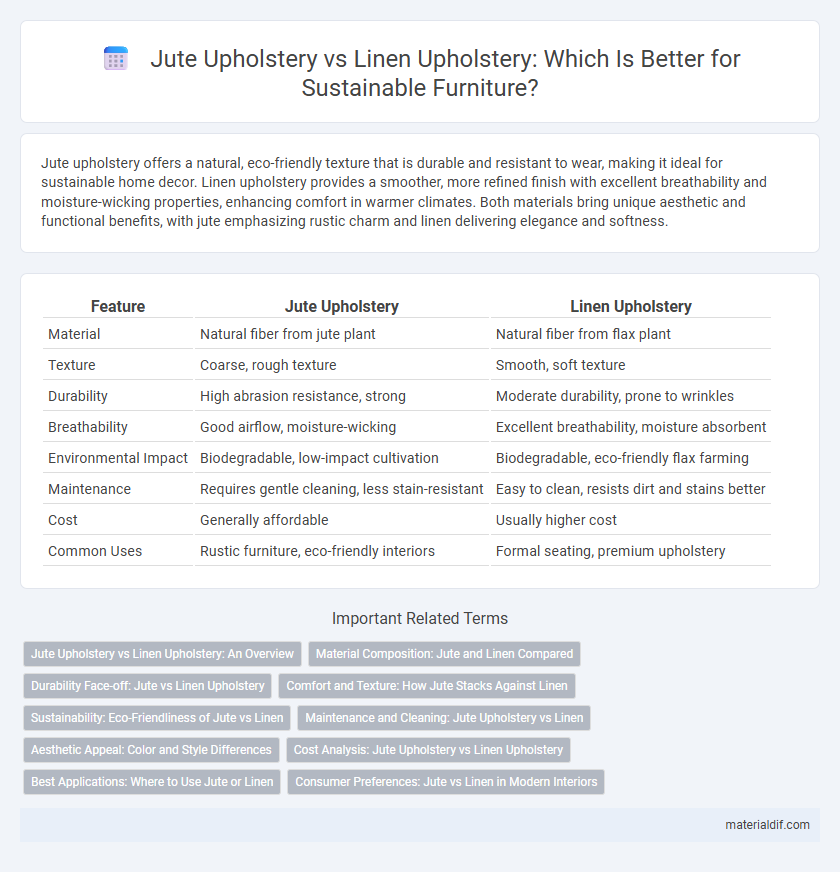Jute upholstery offers a natural, eco-friendly texture that is durable and resistant to wear, making it ideal for sustainable home decor. Linen upholstery provides a smoother, more refined finish with excellent breathability and moisture-wicking properties, enhancing comfort in warmer climates. Both materials bring unique aesthetic and functional benefits, with jute emphasizing rustic charm and linen delivering elegance and softness.
Table of Comparison
| Feature | Jute Upholstery | Linen Upholstery |
|---|---|---|
| Material | Natural fiber from jute plant | Natural fiber from flax plant |
| Texture | Coarse, rough texture | Smooth, soft texture |
| Durability | High abrasion resistance, strong | Moderate durability, prone to wrinkles |
| Breathability | Good airflow, moisture-wicking | Excellent breathability, moisture absorbent |
| Environmental Impact | Biodegradable, low-impact cultivation | Biodegradable, eco-friendly flax farming |
| Maintenance | Requires gentle cleaning, less stain-resistant | Easy to clean, resists dirt and stains better |
| Cost | Generally affordable | Usually higher cost |
| Common Uses | Rustic furniture, eco-friendly interiors | Formal seating, premium upholstery |
Jute Upholstery vs Linen Upholstery: An Overview
Jute upholstery offers natural durability and eco-friendliness with a coarse texture ideal for rustic, sustainable home decor, while linen upholstery provides a smoother, breathable fabric known for its elegance and softness. Jute's strong fibers resist wear and are more affordable, making it suitable for heavy-use furniture, whereas linen requires delicate maintenance but enhances aesthetic appeal with its refined look. Both materials are biodegradable, but jute's moisture resistance surpasses linen, influencing longevity in varied climates.
Material Composition: Jute and Linen Compared
Jute upholstery is made from natural plant fibers derived from the Corchorus plant, characterized by its coarse texture and high durability, making it ideal for rustic or earthy interior designs. Linen upholstery, on the other hand, originates from the flax plant and boasts a smoother, softer texture with superior breathability and moisture-wicking properties, offering a refined and elegant appearance. The contrasting fiber structures in jute and linen directly influence their strength, flexibility, and aesthetic appeal, guiding material selection based on durability requirements and design preferences.
Durability Face-off: Jute vs Linen Upholstery
Jute upholstery offers exceptional durability due to its strong, coarse fibers, making it resistant to wear and tear in high-traffic areas. Linen upholstery, while slightly more delicate, provides a smoother texture with moderate durability, suited for lower-traffic environments. When comparing durability, jute outperforms linen in resistance to abrasion and longevity, making it ideal for long-lasting furniture applications.
Comfort and Texture: How Jute Stacks Against Linen
Jute upholstery offers a coarse, rustic texture that provides durability but lacks the softness found in linen, making it less comfortable for prolonged seating. Linen upholstery features a smooth, breathable fabric that enhances comfort with its natural flexibility and softness, ideal for sensitive skin. Jute is better suited for aesthetic appeal in rugged settings, while linen excels in delivering superior tactile comfort for everyday use.
Sustainability: Eco-Friendliness of Jute vs Linen
Jute upholstery is highly sustainable due to its rapid growth cycle and minimal pesticide use, making it an eco-friendly choice with a low environmental footprint. Linen upholstery, derived from flax, also ranks high in sustainability because flax requires less water and chemicals compared to cotton, but tends to have a longer processing time. Both materials are biodegradable and renewable, yet jute's quicker cultivation and lower resource demand offer a slight ecological advantage over linen in sustainable upholstery options.
Maintenance and Cleaning: Jute Upholstery vs Linen
Jute upholstery requires gentle vacuuming and spot cleaning with mild soap to prevent fiber damage, as its natural rough texture is more prone to moisture absorption and staining. Linen upholstery offers easier maintenance due to its smooth, tightly woven fibers, allowing for more frequent cleaning and better resistance to dirt and spills. Both materials benefit from regular airing, but linen's durability makes it more forgiving in high-traffic areas compared to jute's delicate nature.
Aesthetic Appeal: Color and Style Differences
Jute upholstery offers a natural, earthy texture with warm golden-brown tones, creating a rustic and organic aesthetic ideal for eco-friendly or bohemian interiors. Linen upholstery features smoother, lighter shades ranging from off-white to soft beige, lending a clean, elegant, and timeless look suited for minimalist and contemporary designs. The color palette and texture differences between jute and linen significantly impact the overall style, with jute emphasizing warmth and texture, while linen highlights crispness and subtle sophistication.
Cost Analysis: Jute Upholstery vs Linen Upholstery
Jute upholstery generally offers a more affordable option compared to linen upholstery due to its lower raw material and production costs, making it suitable for budget-conscious consumers. Linen upholstery, while pricier, provides enhanced durability and a luxurious texture that can justify the higher investment for long-term use. Considering factors like maintenance, lifespan, and initial expense helps determine the most cost-effective choice between jute and linen upholstery for specific applications.
Best Applications: Where to Use Jute or Linen
Jute upholstery excels in rustic, eco-friendly interior designs, making it ideal for casual living spaces, cottages, and outdoor furniture due to its durability and natural texture. Linen upholstery suits formal settings such as dining rooms and elegant lounges, offering a smooth, breathable fabric that ages beautifully with time. Choosing between jute and linen depends on the desired aesthetic and functional needs, with jute favored for rugged charm and linen preferred for refined comfort.
Consumer Preferences: Jute vs Linen in Modern Interiors
Jute upholstery appeals to consumers seeking eco-friendly, durable, and affordable materials, often favored for its earthy texture and rustic aesthetic in modern interiors. Linen upholstery attracts buyers who prioritize a smooth, breathable fabric with a refined, natural sheen, offering elegance and comfort. Consumer preferences increasingly reflect a balance between sustainability and style, with jute selected for rugged charm and linen chosen for understated sophistication.
Jute Upholstery vs Linen Upholstery Infographic

 materialdif.com
materialdif.com